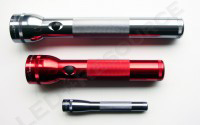 Most of us probably have a Maglite of some sort sitting around the house. Known for their superior build quality and durability, Maglite is considered to be the everyday premium flashlight. We will be taking a look at Maglite’s LED line of flashlights featuring the latest Luxeon Rebel LED.
Most of us probably have a Maglite of some sort sitting around the house. Known for their superior build quality and durability, Maglite is considered to be the everyday premium flashlight. We will be taking a look at Maglite’s LED line of flashlights featuring the latest Luxeon Rebel LED.
Form Factors
The LED Maglite is available in several form factors and with two kinds of LEDs, and the type of LED is something that should be given some thought as there is a significant difference.
LED
Older lights are frequently still seen on the shelf, so the kind of LED should be noted. The current LED Maglites use the Cree XP-E LED, and previous generation LED Maglites use the Philips Lumileds Luxeon Rebel or Luxeon III LED. The Cree XP-E is brighter and more energy efficient than both Luxeon LEDs, however, older models are often mixed with new stock on retail shelves.
The Luxeon III (left) is larger than the Luxeon Rebel (right). The Cree XP-E is mounted similar to the Luxeon Rebel, and the main difference is the square base of the XP-E. The only way to differentiate between the models is to look down the business end of the light through the clear plastic packaging.
With the D-cell lights, the serial number also indicates the type of LED inside. If the serial number begins with DLXXXXXXXXX, it is either Cree XP-E or Luxeon Rebel. If the serial number begins with DXXXXXXXXXX, it is the Luxeon III. Also, if the packaging mentions interchangeability with incandescent bulbs, then it is the Luxeon III.
Sizes
Here’s the breakdown of the sizes that are available based on LED type:
| Luxeon III | Luxeon Rebel | Cree XP-E |
| 2 AA | 2 AA | 2 AA |
| 3 AA | ||
| 2 D | 2 D | 2 D |
| 3 D | 3 D | 3 D |
| 4 D |
The 2AA light is an exception and is actually available in three different form factors. There are two types of the 2AA with the Luxeon Rebel – one with the flat tail cap (old), and one with the lanyard tail cap (current), similar to the regular 2AA Mini Maglite. The lanyard tail cap is preferable to the flat tail cap due to increased reliability, as well as compatibility with regular Mini Maglite tail caps (making aftermarket accessories such as “clickie” switches usable).
A common question is 2D or 3D? The gist of that decision is personal preference. The 3D is a hefty light, but it has, by far, the longest runtime. The 2D is more compact, but runtime is shorter due to the need for voltage boost. The difference in brightness between the two is not very significant, so considerations should fall on runtime and size.
Pricing & Ordering
Compared to other premium flashlights, Maglites have one major advantage – local availability. At the time of writing, regular price for the 2AA is usually around $20.
Frys and Lowe’s also sell the lights online, but after reading the previous section, you will know that ordering online is not a good idea. I was able to pick up several 2AA lights for about $10 each, at Lowe’s and Home Depot during the year-end holiday sale.
The 2D and 3D models are a little more expensive, at around $30 for either. If you are a Costco member or know someone who is, Costco has a 2AA and 3D twin-pack that is a great deal for $29.99. Again, prices vary by time and location, so this should only be interpreted as an estimate.
In The Box
For the 2AA, included in the blister packaging are: Maglite LED 2AA flashlight, 2 x AA battery, and belt holster.
For the D-cell models, only the light is included.
Batteries
While the 2AA includes two alkaline batteries and the instructions specify that only alkaline batteries should be used, it is not recommended to use alkaline batteries. The reasoning behind this is that no matter the brand, alkaline batteries can and will leak! If the light is stored in extreme conditions, such as in the glove box of a car, the chances of leakage are much higher. Instead, lithium primaries or low self-discharge (LSD) NiMH rechargeable batteries are better alternatives.
Lithium primary batteries, such as Energizer Advanced or Ultimate Lithium, are more expensive, but last longer than alkaline, perform better in cold temperatures, do not leak, and are approximately 1/3 lighter than the average alkaline. The voltages of these batteries are also slightly higher, which leads to increased output compared to alkaline.
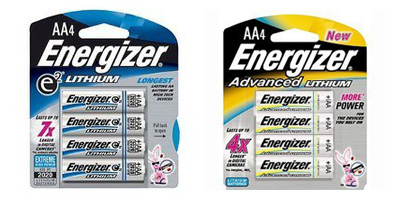
LSD NiMH rechargeables, such as the Sanyo Eneloop that popularized low self-discharge, are able to retain charge up to one year. One thing to note about LSD rechargeables is that Duracell Pre-Charged rechargeable batteries that have a white top on the positive end are re-packaged Eneloops, and these are preferred over the black top counterparts. If you’ve ever used rechargeable batteries, you’re probably aware of the extremely high self-discharge rate that could leave the battery half-empty in a short amount of time. LSD rechargeables are an investment that will definitely pay itself off if the light is used frequently.
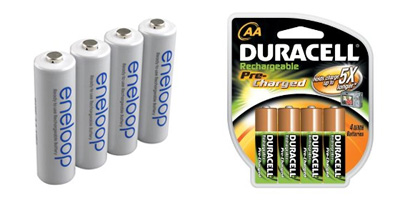
For D-cell lights, options are more limited, and quality alkaline batteries are a good choice. Rechargeable LSD NiMH D-cells are quiet expensive and difficult to find, though AA to D adapters can be purchased online so that primary or LSD AA’s may be used. Some adapters offer the ability to hold 2 AA’s in parallel, which will greatly increase runtime. In addition, 2 AA’s will be lighter than a D-cell.
The Light
Head
The head features a plastic lens and a smooth reflector. The beam can be focused with a quick turn of the head, and the D-cell models feature continuous cam action so which direction the head is turned will not matter.
For the 2AA model, brightness will decrease beyond a half-turn due to increased distance between the LED and the reflector, but the head can be unscrewed all the way and the light converted into “candle mode”
Body
The entire light is type-II anodized aluminum inside and out. The anodizing helps prevent corrosion, and also electrically insulates the light. (Picture below shows lights with optional anti-roll ring accessory.)
The 2AA light sports a multi-mode switch with four modes: 100%, 25%, blink, and SOS. If the light is needed for an extended period of time, one set of batteries will last for more than a day on 25% mode.
The D-cell lights feature a three position on/off switch: momentary, on, and off.
Tail Cap
D-cell lights with the Luxeon III will have a spare incandescent bulb in the tail cap. For the Luxeon Rebel models, the tail cap is not very interesting and consists of only a spring.
Performance
If you’re an incandescent Maglite user, you will certainly be surprised with the output of the LED Maglite. LEDs give off a cool white color, do not generate as much heat, and are brighter. As with incandescent Maglites, the larger models can be used as a baton if needed, although using the head as the striking surface would not be best as the LED cannot be replaced like a bulb! Below are some beamshots of the lights in spot focus:
Below are ANSI technical specifications for most of the Maglite product line.
| Model | Bulb Type | Lumens | Runtime (High) | Runtime (Low) |
| Solitaire (1 AAA) | Krypton (Standard) | 2 | 3h 45m | – |
| XL50 (3 AAA) | LED (Luxeon Rebel) | 104 | 8h 45m | 36h |
| XL100 (3 AAA) | LED (Luxeon Rebel) | 83 | 5h 15m | 201h |
| XL200 (3 AAA) | LED (Cree XP-G) | 172 | 2h 30m | 218h |
| MAG-TAC (2 123A) | LED (Cree XP-G) | 250 | 4h 30m | TBD |
| 2 AAA | Krypton (Standard) | 9 | 2h 30m | – |
| 2 AA | Krypton (Standard) | 12 | 5h 15m | – |
| 2 AA | Xenon (Optional) | 14 | 5h 15m | – |
| 2 AA | LED (Luxeon Rebel) | 69 | 18h | 31h |
| 2 AA | LED (Cree XP-E) | 63 | 9h 30m | 24h |
| 2 AA Pro | LED (Cree XP-G) | TBD | TBD | – |
| 2 AA Pro Plus | LED (Cree XP-G) | TBD | TBD | TBD |
| ML100 (2 C) | LED (Cree XP-E) | 119 | 11h | 43h |
| ML100 (3 C) | LED (Cree XP-E) | 101 | 35h | 98h |
| ML125 (3 C or NiMH) | LED (Cree XP-G) | 186 | 8h 30m | 30h |
| 2 D | Krypton (Standard) | 19 | 10h | – |
| 2 D | LED (Luxeon Rebel) | 114 | 9h 15m | – |
| 2 D | LED (Cree XP-E) | 134 | TBD | – |
| 3 D | Krypton (Standard) | 45 | 10h | – |
| 3 D | LED (Luxeon Rebel) | 104 | 72h | – |
| 3 D | LED (Cree XP-E) | 131 | TBD | – |
| 4 D | Krypton (Standard) | 72 | 10h | – |
| 5 D | Krypton (Standard) | 113 | 11h | – |
| 6 D | Krypton (Standard) | 136 | 11h | – |
| MagCharger (NiMH) | Halogen (Standard) | 221 | 3h | – |
All of the LED Maglites are regulated, which means that as the batteries are depleted and voltage drops, more current is drawn from the batteries to offset the lower voltage, resulting in consistent brightness until the batteries are completely depleted.
Runtime
If you haven’t read our article about runtime graphs and the ANSI FL1 Standard, please click here.
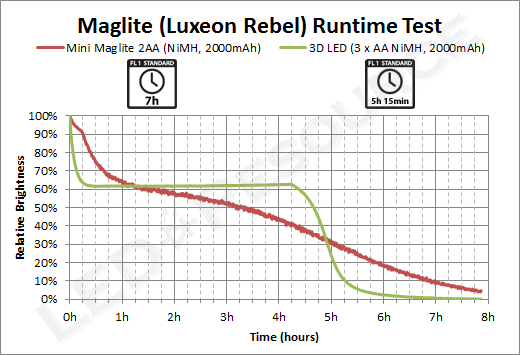
Accessories and Upgrades
Maglite offers a decent variety of OEM accessories for their lights, ranging from belt holders to lamps to traffic wands. I purchased a D-cell and an AA accessory pack, which came with a rubber anti-roll ring that also protects the head and lens from scratches when set down head-first, as well as a set of red, blue, and clear lenses. The D-cell accessory pack also came with a pair of mounting brackets, which I found to be convenient for storing the light. The mounting brackets are quite firm and the light snaps in with a solid THUNK.
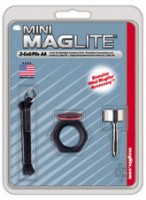
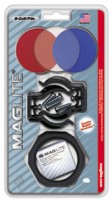
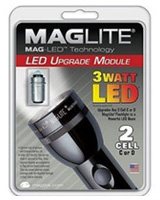
For those with incandescent Maglites, Maglite offers a 3W drop-in LED upgrade for the 2-cell, 3-cell, and 4-cell C or D lights, which uses the Luxeon III LED. This upgrade is being discontinued due to the older LED used, but there are aftermarket upgrades (including some with the Luxeon Rebel LED) available from manufacturers such as TerraLUX. For Mini Maglites, there are no OEM upgrades, but TerraLUX and Nite-Ize make 1W LED upgrades that will certainly improve the light’s usefulness.
Conclusion
These lights are certainly quite handy to have around! The size of the 2AA makes a great every-day carry (EDC) light, or could be handy to keep in glove boxes or emergency kits (with lithium batteries installed, of course). Whether you’re an avid outdoorsman or just wandering around the house late at night trying to find your bedroom, these lights are great value and will come in handy, ready for action, for years to come.
Related Links

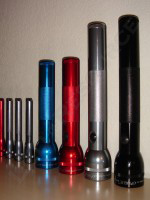
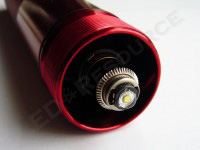
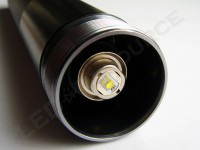
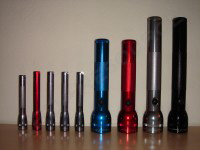
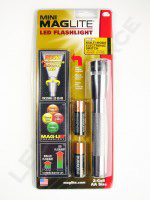
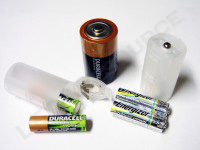
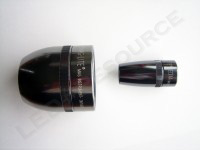
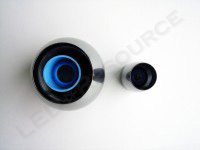
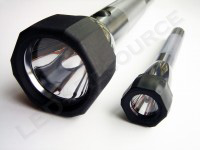
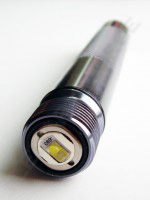
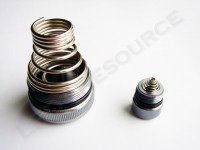
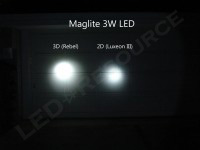
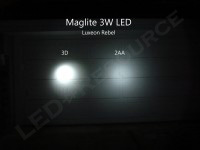


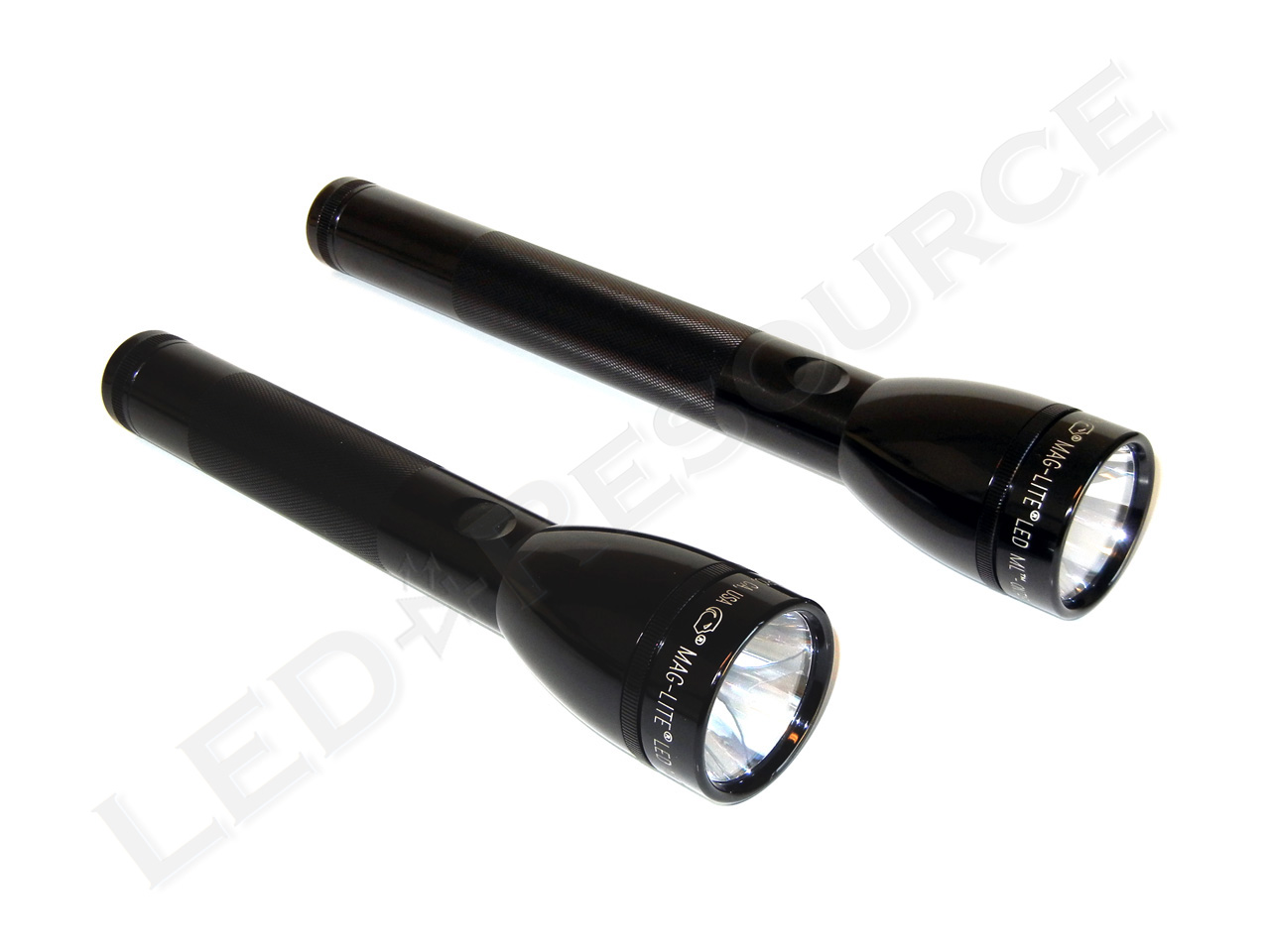

Very nice review.. appreciate your efforts and many thanks for that.. I went to buy mag led but confused seeing two types of leds in almost the same looking packages.. came back and browsed and here i found the right review and then picked Luxon Rebel one from costco.. Thanks a lot.
Verry goods maglite edc
Thanks for a greatly useful presentation. It appears from above I have a Maglite LED Flashlight with the Luxeon Rebel LED assembly and the lanyard accomodating end-cap.
Model: SP2201HJ
P/N: 153-000-050
I am powering it with rechargeable eneloop AA cells.
I have some questions (please feel free to ignore them):
1. Being a tinkerer I would like to upgrade it in any way I can. What are the possibilities?
2. I would like to add a flood mode w/o hot spots somehow.
3. I see that very efficient lenses are available for it from http://www.flashlightlens.com. How much would these improve performance (i.e. what kind of lenses does it have now)?
4. I notice that Luxeon Rebel LED’s are available in various output ranges or bins (http://www.luxeonstar.com), (“h” being 60 lm max @350 ma and “s” being 200 lm max @ 350 ma. What’s involved in swapping the stock “h” for a higher output LED assy closer to an “s”?
5. If you replace the end-cap with a click-switch cap, what are the control results (how do you operate it?).
Thanks again.
Ed,
1. LED flashlights generally can’t be modified easily due to complexity with the electronics.
2. Unfortunately, the smooth reflector does not allow this. Smooth reflectors are designed for throw. A couple ideas for a floody beam: stick opaque tape on window or put a white/clear water bottle lid on the bezel (a more elegant approach to this would be to buy a SureFire F04 diffuser).
3. Glass windows allow more light transmission, but the difference is so small, it’s generally unnoticeable. However, glass is harder to scratch (but don’t drop the light!). I managed to scratch the OEM plastic on mine by wiping dust off with a soft cloth, so I got an OEM glass window (P/N 108-617). Scratching the plastic window will affect light output, and if it is heavily scratched, it may even alter the beam.
4. De-soldering the LED is necessary. LEDs are easily damaged by heat, so reflow soldering is used for LEDs.
5. If you get a standard click-switch (such as TerraLUX TCS-1), you can leave the head unscrewed and use the tailcap to control on/off and change modes.
Hope this helps! Feel free to head over to our forum if you have more questions, as it’s easier to discuss there.
Hi, do you know the lumens rate of the 2AA Luxeon III ?
I just bought a Maglite combination pack at Costco, containing a MiniMaglite 2AA flashlight and a 3D LED flashlight for $29.99. The LED in the 3D flashlight does not look like *either* the Luxeon III or the Luxeon Rebel. I already have a 2D flashlight with the Luxeon Rebel LED, and the LED in the 3D flashlight is not the same! Yet, serial number prefix is “DL3” and there is no spare bulb in the tail cap.
Drew,
You have a good point there, I need to update the article. What you have there is the latest version of the 3D LED, which uses the Cree XP-E LED.
The 3D Cree XP-E is actually 104 not 130 lumens. LED number 484 on the chip.
104 lumens is for the Luxeon Rebel version, the light was in old packaging. Newer build XP-E lights should have updated specs on the package.
I found the answer on the net about the 2AA Luxeon III lumens rate:
~ 38 lumens.
The 2D-LED flashlight batteries last 9.15 hours and 3D-LED 72 hours?
This is right?
Na lanterna 2D-LED as pilhas duram 9,15 horas e na 3D-LED 72 horas?
Isto está certo?
2D LED (newest version) – 8h (at 8h the output is just 10% of 134 lumens)
3D LED – 79h (at 79h the output is just 10% of 131 lumens)
So, the extra battery of the 3D will produce a long “slow death”, many hours of low output.
A bateria extra da 3D vai produzir muitas e muitas horas de luz mais fraca. Não vale a pena. A 2D é mais leve e mais forte ao longo das 8 horas.
Kudos for the new runtime graphs, Robin. For the 3D and Minimag combined runtime graph, which emitter did the 3D have?
Also, the scale cannot be used to compare actual brightness between the 3D and the Minimag, correct? (unless perhaps it was the Lux. III 3D drop-in?) Thanks.
*facepalm* the chart header says Luxeon Rebel.
I ordered Mini Maglite LED 2AA from ebay.
It’s model mumber is SP2201HY, is it the latest generation Mini Maglite or the older/obsolete version.
Is it one with 3Watt bulb? on net there are two types of Mini Maglite LED packs, some have 3 watt mentioned on them, some have not. Which one to buy ??
It’s impossible to tell from the model number. If it says 3W LED on it, it’s an older model. New models will say 77 lumens on the packaging and have 106 printed on the LED module.
Robin
Dear Robin,
Thanks for the reviews. Hopefully, you can update it ? Well Robin, I’m looking for the latest best
LED maglite flashlight available today with the obvious following features:
1. Longest throw
2. Highest Lumens
3. Least battery drain (Maximum runtime ? )
4. Best LED module (3rd generation LED Technology ? )
Thank you so much!
Best Regards,
Luke Fernando
Luke,
Since Maglite has updated (or is updating) most of their product line, this article is now mostly outdated. You can see our reviews of Maglite products by selecting the category “MFG: Mag Instrument” or compare their upcoming products in our “Upcoming LED Products” page.
Hope this helps!
Robin
Table does not have data for the Luxeon III. About the same as the Rebel ?
And no data for any 4D LED (I have a 4D with the “D” serial number so its a Luxeon III)
Did you transpose the data for the 2AA Cree and Luxeon? The Cree is showing less performance.
Great review.
Been reading labels on the packages and the ANSI specs that are usually on the packages and been wondering what was up. Yours is the first article that was soo complete that it answered why I’ve seen such differences.
This is the first time I’ve seen such a nice , complete , pulled together overview of the maglites.
Great job on the reviews in general. Lots of good information.
If I could suggest one thing, it would be to include the ASNI spec chart that is commonly seen on the instructions for packaging for each flashlight. As a buyer searching and reading about the lights, I get use to seeing them now and to see them in the reviews would be great. I know you do a great job listing the spec’s in a bulleted form, but the ansi spec graphics have grown on me as a shopper.